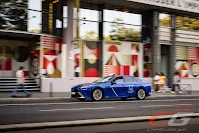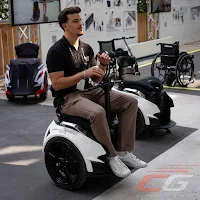Here’s a little-known fact: while Paris has hosted three Olympics, 2024 marked the first time the city hosted a Paralympic Games. As experienced in previous host cities, the Games is often seen as an accelerant in improving the accessibility of people with disabilities. And with a promise of hosting a “Games Wide Open,” Paris put that promise front and center.
A city re-thought for seamless accessibility is one of the lasting legacies of the Paralympics; it’s one that far outlasts the euphoria of the crowds, the medals, and the sports themselves. In a lead up to the Games, Paris spent a huge amount of money—some say to the tune of 125 million euros—to repair cracked pavements, widen sidewalks, re-paint pedestrian crossings, and more.
Yet, the biggest pain point when it comes to accessibility is, according to Parisians themselves, the city’s very own transportation network. Three years before the Paralympics, only half of total bus stops accommodated accessibility ramps and only 9 percent of its metro system can be used by wheelchair users. Before the opening ceremonies, that number stood at 100 percent.
The dedication of leaving no one behind is something that rings true at Toyota—the first-ever mobility sponsor of the Olympics and Paralympic Games. In this role, Toyota isn’t just paying good money to have their branding splattered on the athletes’ uniforms and collaterals. Rather, it’s about providing sustainable, safer, more efficient mobility solutions for everyone.
“Everyone” and “solutions” must be emphasized because Toyota won’t just be providing a fleet of Priuses, Mirais, and bZ4Xs, and call it a day. It’s also about providing and managing this fleet effectively through several solutions. They also have to include last-mile mobility requirements as well, an important factor for the 4,000 athletes taking part at the Games.
This is highlighted at the Toyota House and Inclusive Mobility Park. Located near the Eiffel Tower, Toyota House is a showcase of the company’s developments from electrification, shared mobility, and infrastructure. Among the displays there are the Lexus LF-ZC Concept, the Lunar Cruiser, and if you look closely, even a scale model of the next-generation Tamaraw.
Across the street is the Inclusive Mobility Park—an interactive display of Toyota’s mobility solutions used at the Paris Paralympic Games. The range included concept mobility vehicles for individuals and groups, such as Accessible People Movers, wheelchair pullers that can reach speeds of up to 40 km/h, and wheelchairs that can drive autonomously or even climb stairs.
The aim of the Mobility Park is for Toyota to promote inclusive mobility for all—its vision as it transitions to become a mobility company. In total, Toyota is providing 700 personal last-mile mobility products accessible through its Kinto app to ensure that athletes, volunteers, and organizers have access to the most inclusive and sustainable mobility fleet ever seen at the Olympic and Paralympic games Paris 2024.
The mobility vehicles present included those supported by Toyota Open Labs, an open innovation platform that brings together startups with business units across the Toyota ecosystem, to help shape the future of mobility.
Yosh-E (Top Speed: 8 km/h. Range: 25 km)
A third wheel electric puller for manual wheelchairs co-developed by Toyota and Austrian company Klaxon, the Yosh-E, clips onto the front of a manual wheelchair, converting it into a battery-powered electric vehicle, giving more freedom to move. Around 200 Yoshi-E pullers will be attached to wheelchairs during the Paralympic Games Paris 2024 and 150 will be used during the opening ceremony.
A GR (Gazoo Racing) version of Yosh-E was inspired by the tech innovation used in the prosthetic leg of South African shot putter and Toyota engineer, Tyrone Pillay. The prosthetic was specially designed to withstand the torque and force when hurling the shot put. Seeking a new use for the technology, the team based at Toyota in Cologne applied the tech to the GR Yosh-E. The Toyota development team included an engineer with only 20 percent vision, one with paralysis on one side of his body and another with an amputation above the knee—so they all understood the needs of someone who is in a wheelchair.
C+ Walk (Top Speed: 9 km/h. Range: 14 km)
An easy to operate 100 percent battery electric three-wheeled vehicle designed to be used in walking areas and available in either a standing or seated format. During the Paralympic opening ceremony, a total of 40 C+ Walk vehicles will be used.
Genny (Top Speed: 15 km/h. Range: 24 km)
A self-balancing personal battery electric transporter that empowers people with reduced mobility to move freely. It sets a new benchmark in micro-mobility, moving beyond traditional four-wheeled vehicles.
Eppur
Eppur, a first, is a braking system for manual wheelchairs which reduces the user’s braking effort by 80 percent. Instead of using the friction of their hands against the wheelchair wheels to slow down or stop, light pressure is applied to the outer rim, which applies a brake. The wheels are compatible with many different types of wheelchairs.
Toyota Juu (Top Speed: 6 km/h)
An electric wheelchair prototype from Toyota that can autonomously climb stairs up to 160 mm in depth while the user is seated, the Toyota Juu empowers wheelchair users to explore previously inaccessible places, unlocking new possibilities in independent mobility.
An electric wheelchair prototype from Toyota that can autonomously climb stairs up to 160 mm in depth while the user is seated, the Toyota Juu empowers wheelchair users to explore previously inaccessible places, unlocking new possibilities in independent mobility.
Whill
This is a last mile electric wheelchair supported by Woven Capital, the investment arm of Toyota Motor Corporation, designed to autonomously transport those with mobility needs around airports, hospitals, and the Paralympic Games. A total of 11 different commercial projects using Whill are currently underway.
This is a last mile electric wheelchair supported by Woven Capital, the investment arm of Toyota Motor Corporation, designed to autonomously transport those with mobility needs around airports, hospitals, and the Paralympic Games. A total of 11 different commercial projects using Whill are currently underway.
Accessible People Mover or APM (Top Speed: 19 km/h. Range: 100 km)
This electric vehicle is accessible for wheelchair users and those with mobility needs, and a total of 250 APMs are being used to transport athletes and supporters in and around the Athlete’s Village and competition sites in Paris. The vehicle can seat up to six people including the driver and can be modified to accommodate wheelchair users.
This electric vehicle is accessible for wheelchair users and those with mobility needs, and a total of 250 APMs are being used to transport athletes and supporters in and around the Athlete’s Village and competition sites in Paris. The vehicle can seat up to six people including the driver and can be modified to accommodate wheelchair users.
The Games were undoubtedly a catalyst for inclusive mobility and the efforts of Paris alongside companies like Toyota should have a lasting effect. This is the legacy and impact of the Games—it transforms the fundamental way of thinking that disability isn’t a challenge nor a problem. In truth, there will be gaps that need bridging and these issues cannot be fixed with the wave of a magic wand. However, a true private-public partnership can make change happen. It’s all about moving forward in a positive direction—one that’s focused on inclusion, to become a more welcoming and more responsible society. It’s a call that unites all mankind.























No comments:
Post a Comment
Feel free to comment or share your views. Comments that are derogatory and/or spam will not be tolerated. We reserve the right to moderate and/or remove comments.